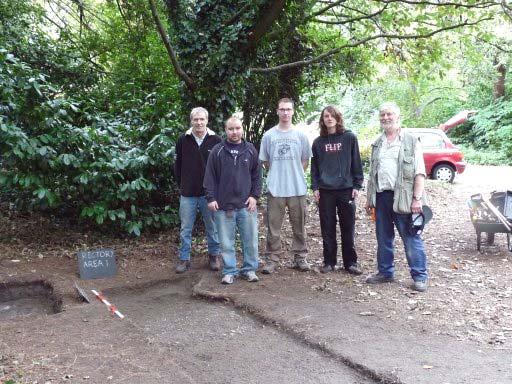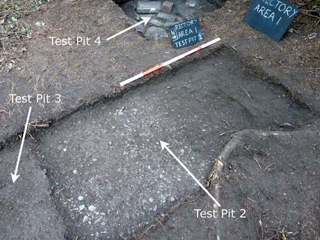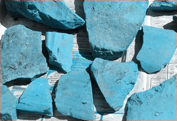
A number of test pits have now been opened on the Rectory site in the area where we previously carried out our resistivity survey - and we have already got some very interesting results.
Test pit 1 was located over the high-res anomaly to the south of the area and revealed, at a depth of about 20cm, a straight edge of hard compacted soil running roughly north-south. On the west side of the edge the soil is much softer. Our initial interpretation is that this is part of the garden feature shown in this area on the 1849 OS map.
Test pit 2 revealed a finely cobbled surface laying just 5cm below the surface. This pit was located just where we expected to find the old road, however its construction of small river pebbles, suggests a path rather than a road. Maps of this area, drawn after the construction of the new hall, indicate that a path was laid here on top of the old road when the grounds of the hall were extended.
 The next test pits were therefore located to try to identify the edges of this path.
Test pit 3, located 1m south of test pit 2, revealed a cinder surface lying just below the top soil.
Test pit 4 was put in just north of test pit 2 but further west in a better hope of catching the edge.
There was no sign of any surface in this one; however at a depth of about 20cm, random sandstone blocks and bricks began to appear suggesting the remains of a wall or maybe the old road.
Test pit 5 (located another 1m south of test pit 3) drew a blank, although its initial depth is only 10cm. When test pit 3 (with the cinder surface) was extended into test pit 2 (with the pebble surface), we realised that the former actual lay over the latter. Careful examination of later maps of this area suggests that the original path was extended to access the rear of the gatehouse which could explain the ciders lying on top of the pebbles. The next test pits were therefore located to try to identify the edges of this path.
Test pit 3, located 1m south of test pit 2, revealed a cinder surface lying just below the top soil.
Test pit 4 was put in just north of test pit 2 but further west in a better hope of catching the edge.
There was no sign of any surface in this one; however at a depth of about 20cm, random sandstone blocks and bricks began to appear suggesting the remains of a wall or maybe the old road.
Test pit 5 (located another 1m south of test pit 3) drew a blank, although its initial depth is only 10cm. When test pit 3 (with the cinder surface) was extended into test pit 2 (with the pebble surface), we realised that the former actual lay over the latter. Careful examination of later maps of this area suggests that the original path was extended to access the rear of the gatehouse which could explain the ciders lying on top of the pebbles.
Lastly extending test pit 2 further north showed that the pebble surface continues a further 50cm before disappearing under the rising embankment to the north.
Regular visits to this site are planned for the coming weeks - so if you are interested in getting involved contact Eric Walter or myself at the next meeting.
Save Wigan
This is the name of a new online heritage group that has been set up to offer support to listed buildings, buildings of interest and monuments in the Wigan area that face an uncertain future. The group, which is associated with the WiganWorld internet site, will be run through membership fee's, donations and funding. For more information check out their website at:
www.savewigan.co.uk
CBA Autumn Conference
'A closer look - the archaeology of people in the Northwest'. Saturday 24th October at the Lytham Assembly Rooms, Dicconson Terrace, Lytham St Annes. Speakers include Peter Carrington, Steve Higham, Rob Philpott and Mike Nevell. Full details at the meeting.
Relocation
Last month's society meeting did not exactly go to plan and I must apologies to all those attending, who had to sit through the 45mins that the EGM took. We did eventually get the changes to our constitution through and we now have a brand new (funding-friendly) bank account. This means we can start to draw on the grant money we have been allocated for the Rectory project. It has however become apparent that there are continuing uncertainties about our future at the Scout HQ venue. We have therefore decided to relocate to the Upper Morris Street Working Men's Club (which happens to be just across the road - please let me know if you need more details of its location).
Next Meeting
Wednesday 7th October in the lounge of the Upper Morris Street Working Men's Club (off Greenough Street), starting at 7.30 pm. This month Rob Philpott from Liverpool Museum will be talking about the Viking Hoard which was found by metal detectorists near Huxley in Cheshire in 2004. In all some 22 silver items together with 39 lead fragments were discovered (obviously not as grand as the Saxon hoard recently announcement in the press but nevertheless a very significant find). One suggested interpretation is that this Viking hoard is bullion buried for safekeeping by Viking refugees who settled in Cheshire and Wirral after being expelled from Dublin by the Irish in 902 AD.
It sounds like a fascinating talk.
Hope to see you there - BA
|



